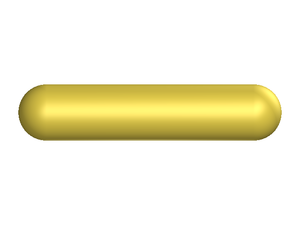Hard spherocylinders: Difference between revisions
Jump to navigation
Jump to search
Carl McBride (talk | contribs) mNo edit summary |
Carl McBride (talk | contribs) mNo edit summary |
||
| Line 1: | Line 1: | ||
{{Stub-general}} | {{Stub-general}} | ||
[[Image:spherocylinder_purple.png|thumb|right]] | [[Image:spherocylinder_purple.png|thumb|right]] | ||
The '''hard spherocylinder''' model consists on an impenetrable cylinder, capped at both ends | |||
by hemispheres whose diameters are the same as the diameter of the cylinder. | |||
The molecular volume of the spherocylinder is given by | The molecular volume of the spherocylinder is given by | ||
Revision as of 15:11, 1 February 2008

The hard spherocylinder model consists on an impenetrable cylinder, capped at both ends by hemispheres whose diameters are the same as the diameter of the cylinder. The molecular volume of the spherocylinder is given by
where is the length of the cylindrical part of the spherocylinder and is the diameter.
See also
References
- Giorgio Cinacchi and Yuri Martínez-Ratón and Luis Mederos and Enrique Velasco "Smectic, nematic, and isotropic phases in binary mixtures of thin and thick hard spherocylinders", Journal of Chemical Physics 124 pp. 234904 (2006)
- P. Bolhuis and D. Frenkel "Tracing the phase boundaries of hard spherocylinders", Journal of Chemical Physics 106 pp. 666-687 (1997)
- S. C. McGrother and D. C. Williamson and G. Jackson "A re-examination of the phase diagram of hard spherocylinders", Journal of Chemical Physics 104 pp. 6755-6771 (1996)


